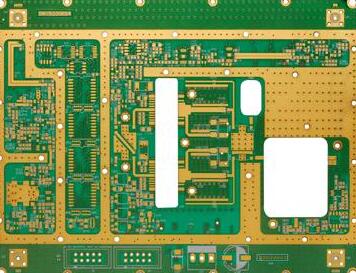There are many surface treatment technologies for high-frequency circuit boards. We have introduced the methods of packaging components on the substrate before, mainly including THT and SMT. So, if there is residual solder on the high-frequency circuit board, which needs to be removed, what method should be used? At this time, high-frequency circuit boards need to use hot air leveling technology.
The surface treatment of high-frequency circuit board hot air leveling is also called tin spraying. The process is: dip the soldering flux on the printed circuit board, put it in the molten solder, and then pass between the two air knives. The hot compressed air in the air knife blows off the excess solder on the printed board, and at the same time removes the excess solder in the metal hole, so as to obtain a bright, smooth and uniform solder coating.

Compared with other processes, hot air leveling is relatively simple. Even so, many programs and extremely coefficients need to be controlled to produce high-quality high-frequency circuit boards. Otherwise, as long as there is a little problem, it may affect The overall quality of the high-frequency circuit board. The procedures and coefficients that need to be paid attention to, ipcb believes that the main points are as follows:
1. Dip tin time
During dip soldering, the base copper and the tin in the solder will generate a layer of metal compound, and at the same time, a layer of solder coating will be formed on the wire. The longer the tin immersion time, the thicker the solder, and the shorter the time, the semi-immersion phenomenon is likely to occur, causing local tin surface to turn white. Under normal circumstances, the immersion tin time is controlled within 2-4 seconds.
2. Tin bath temperature
The temperature of the tin bath needs to be controlled within a certain range. If it is too low, it will not work. If it is too high, the substrate will be damaged, and it will cause the tin alloy and copper to react. Under normal circumstances, the temperature is controlled at about 230-250°C.
3. Blowing time
The blowing time of the air knife mainly affects the coating thickness of the solder. Long time, the coating is thinner, and the coating inside the hole is also thin. Short time will produce irregular plugging. Generally, the blowing time of the air knife is 1 -3 seconds.
4. Air knife pressure
The function of the air knife is to blow off the excess solder and conduct the metallized holes without reducing the diameter of the metallized holes too much. Usually, the air knife pressure is controlled to be 0.3-0.5mpa.
5. Air knife temperature
The temperature of the air knife has a certain effect on the appearance of the leveled solder coating. If the temperature is too low, the coating surface will become dark, and if it is too high, it will cause damage. The temperature of the air knife is generally controlled between 300-400°C.
6. Air knife angle
If the angle of the air knife is too high, the hole will be blocked. Improper adjustment of the angle will cause the thickness of the solder on both sides of the board to be different, and it will also cause the molten solder to splash. Under normal circumstances, the front wind knife is 3-50°, and the rear wind knife is 4-70°